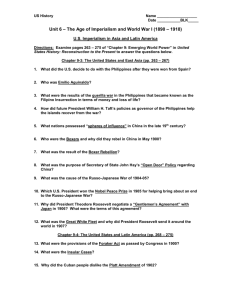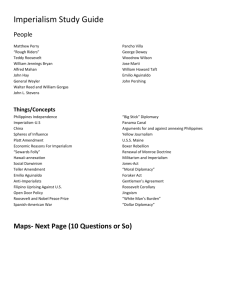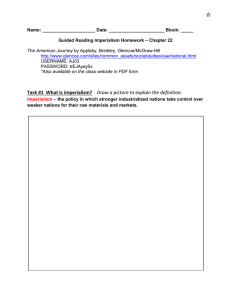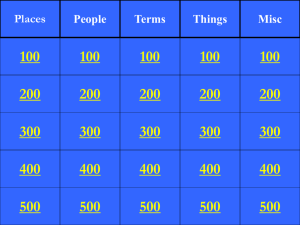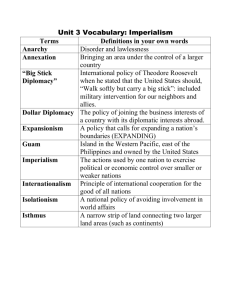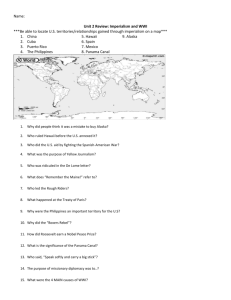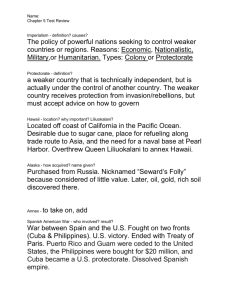Unit 4: Imperialism & WWI
advertisement
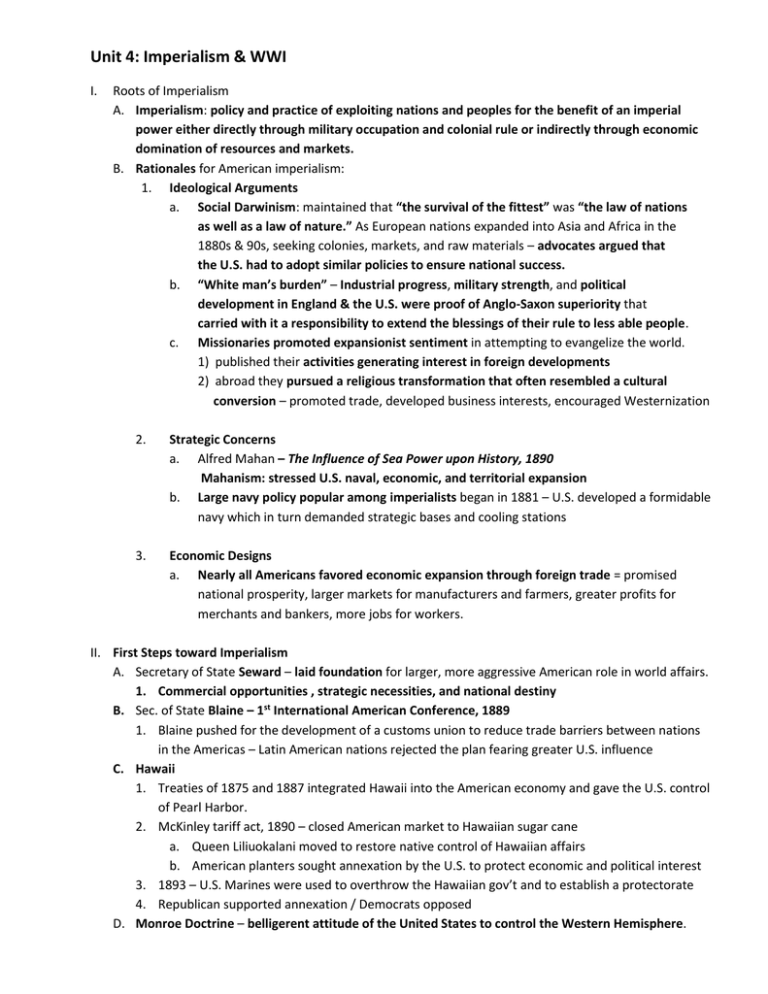
Unit 4: Imperialism & WWI I. Roots of Imperialism A. Imperialism: policy and practice of exploiting nations and peoples for the benefit of an imperial power either directly through military occupation and colonial rule or indirectly through economic domination of resources and markets. B. Rationales for American imperialism: 1. Ideological Arguments a. Social Darwinism: maintained that “the survival of the fittest” was “the law of nations as well as a law of nature.” As European nations expanded into Asia and Africa in the 1880s & 90s, seeking colonies, markets, and raw materials – advocates argued that the U.S. had to adopt similar policies to ensure national success. b. “White man’s burden” – Industrial progress, military strength, and political development in England & the U.S. were proof of Anglo-Saxon superiority that carried with it a responsibility to extend the blessings of their rule to less able people. c. Missionaries promoted expansionist sentiment in attempting to evangelize the world. 1) published their activities generating interest in foreign developments 2) abroad they pursued a religious transformation that often resembled a cultural conversion – promoted trade, developed business interests, encouraged Westernization 2. Strategic Concerns a. Alfred Mahan – The Influence of Sea Power upon History, 1890 Mahanism: stressed U.S. naval, economic, and territorial expansion b. Large navy policy popular among imperialists began in 1881 – U.S. developed a formidable navy which in turn demanded strategic bases and cooling stations 3. Economic Designs a. Nearly all Americans favored economic expansion through foreign trade = promised national prosperity, larger markets for manufacturers and farmers, greater profits for merchants and bankers, more jobs for workers. II. First Steps toward Imperialism A. Secretary of State Seward – laid foundation for larger, more aggressive American role in world affairs. 1. Commercial opportunities , strategic necessities, and national destiny B. Sec. of State Blaine – 1st International American Conference, 1889 1. Blaine pushed for the development of a customs union to reduce trade barriers between nations in the Americas – Latin American nations rejected the plan fearing greater U.S. influence C. Hawaii 1. Treaties of 1875 and 1887 integrated Hawaii into the American economy and gave the U.S. control of Pearl Harbor. 2. McKinley tariff act, 1890 – closed American market to Hawaiian sugar cane a. Queen Liliuokalani moved to restore native control of Hawaiian affairs b. American planters sought annexation by the U.S. to protect economic and political interest 3. 1893 – U.S. Marines were used to overthrow the Hawaiian gov’t and to establish a protectorate 4. Republican supported annexation / Democrats opposed D. Monroe Doctrine – belligerent attitude of the United States to control the Western Hemisphere. III. Spanish-American War, 1898 A. Cuban Revolution, 1895 – harsh Spanish control led to Cuban rebellion 1. American economic interest were severely affected – destroyed property & disrupted trade 2. Spanish brutality – civilians herded into “reconcentration camps” died of starvation and disease. B. Yellow Press – sensationalized press which used bold headlines, fevered editorials, and real or exaggerated stories of violence, sex, and corruption = stimulated American interest in the Cuban war. 1. The nations religious press reflected the prejudice of Protestant Americans against Catholic Spain. C. U.S. battleship Maine – blew up in Havana, Cuba harbor killing 260 sailors. 1. Explosions caused by an accident on board but used as a reason to declare war against Spain. “war was compatible with our national honor” – Teddy Roosevelt 2. Congress declare war on April 25, 1898 3. Teller Amendment – added by Congress to the war resolution: stated that the United States had no intention of annexing Cuba and promised that Cubans would govern themselves. D. Philippines 1. Commodore George Dewey led the U.S. Asiatic squadron into Manila Bay and destroyed the weaker Spanish fleet on May 1, 1898. a. Manila Bay – navy had coveted the bay as a strategic harbor b. Commercial opportunities in China were now open to U.S. interest 2. Hawaii was annexed in 1898 – strategic importance as stepping stone to the Philippines 3. Inept victory in Cuba – 5,000 U.S. soldiers died due to poor management by the Defense Dept. a. Teddy Roosevelt’s Rough Riders b. U.S. navy defeated Spanish fleet isolating Spanish troops in the Caribbean c. Puerto Rico was captured with little opposition E. Treaty of Paris 1. Required Spain to accept Cuban independence, cede Puerto Rico and Guam, and the Philippines to the United States 2. Debate over the ratification of the treaty in the united States a. Expansionist favored the acquisition of the Philippines 1) To protect American business interest in China 2) To get the valuable resources of the Philippines that other European nations might take if the U.S. did not 3) Religious press stated the desirability of America’s retaining the Philippines as a duty in the interest of human freedom and Christian progress b. Opponents of the treaty 1) Imperialism was a repudiation of America’s moral and political traditions embodied in the Dec. of Ind. 2) Acquisition of overseas colonies conflicted with the nation’s commitment to liberty and its claim to moral superiority 3) Other objected on racist grounds – that Filipinos were inferior and unassimilable 3. The treaty was ratified by the Senate on Feb. 6, 1899 IV. American Imperialism in East Asia 1899-1917 A. Filipino-American War 1. Filipino leader, Emilio Aguinaldo – issued declaration of independence and Proclaimed the Philippine Republic following Dewey’s defeat of the Spanish navy at Manila. 2. Treaty of Paris – provided U.S. ownership rather than independence of the Philippines 3. Battle between U.S. and Filipino troops outside Manila, Feb. 4, 1899 – sparked a long brutal war 4. Racism – U.S. used brutal force to suppress Filipino’s which was excused as racial superiority 5. By 1902 – Philippines under U.S. control = construction of new schools, roads, public health system, and economy tied closely to U.S B. China & the Open Door Policy 1890’s 1. Major European powers, U.S. and Japan competed aggressively to claim areas of China as their own spheres of influence. 2. U.S. “Open Door” policy – Sec. of State John Hay a. Influenced by the American business community who sought an equal opportunity to compete for the markets of China b. The policy asked the imperial powers to maintain and Open Door for the commercial and financial activities of all nations within their Chinese spheres of influence c. Boxer rebellion, 1900 – anti-foreign Chinese nationalist movement which laid siege to the diplomatic quarters in Beijing was defeated by a multinational military force d. Open Door became a cardinal doctrine of American foreign policy in the 20th century – promoted an informal or economic empire, as opposed to the traditional territorial colonial empire identified with European empires. 3. Rivalry with Russia & Japan: Both opposed American Open Door policy a. Russo-Japanese War 1904: ended with Treaty of Porstmouth in 1905 – marked Japans emergence as an imperial power V. American Imperialism in Latin America, 1899-1917 A. Puerto Rico 1. Insular Cases (1901) – Supreme Court upheld Congress’s authority to establish an inferior status for Puerto Rico as an “unincorporated territory” without promise of statehood B. Cuba as a Protectorate 1. Platt Amendment – restricted Cuba’s autonomy in diplomatic relations with other countries and in internal financial policies. a. Required Cuba to lease naval bases to the U.S. and authorized U.S. intervention to maintain order. C. Panama Canal 1. President Teddy Roosevelt: “Speak softly and carry a big stick” – reflected his approach to foreign policy because his negotiations were always backed by the threat of military force. 2. Roosevelt’s canal diplomacy helped establish the assertive presidency that has characterized U.S. foreign policy in the 20th century. a. 1902 – Congress directed Roosevelt to purchase the French company’s claims for $40 million and build the canal in Panama. b. 1903 – Roosevelt pressed Colombia to sell the canal zone to the U.S. for $10 million – Colombia refused wanting more money & fearing the loss of its sovereignty in Panama. c. 1904 – Roosevelt worked with Philippe Bunau-Varilla (director of the Panama Canal Company) To coordinate a “bloodless” revolt in Panama = When Colombia attempted to land troops in Panama the U.S. navy blocked them resulting in a successful revolt. d. Treaty of Hay - Bunau-Varilla, 1904: The Panama Canal zone became a U.S. protectorate 3. Advantages of the Panama Canal 1) Saved in shipping costs of the longer route around South America 2) Sped up the travel time from East to West coast 3) Provided for a strong military presence in Central America. D. Roosevelt Corollary, 1904 – A new policy to the Monroe Doctrine which expressed American hostility to European intervention in Latin America. 1. Roosevelt Corollary attempted to justify U.S. intervention and authority in the region. a. Roosevelt invoked his corollary immediately, imposing American management of the debts and customs duties of the Dominican Republic in 1905 b. Drago Doctrine, 1907 – incorporated into international law by Latin American nations in protest of Roosevelt’s Corollary, prohibited armed intervention to collect debts. E. Dollar Diplomacy – adopted by Roosevelt’s successor William Howard Taft = hoped to promote U.S. interests without such combative rhetoric and naked force. 1. “substitution of dollars for bullets” – using government action to encourage private American investments in Latin America to supplant (undermine) European interests, promote development and stability, and gain profits for American bankers 2. Taft employed military force more frequently than Roosevelt had a. Nicaragua in 1909 and 1909 – U.S. troops used to increase American private interest 3. Dollar diplomacy increased American power and influence in the Caribbean and tied underdeveloped countries to the U.S. economically and strategically. VI. Waging Neutrality (World War I) A. American isolationism: 1. United States had no vital interest in the war & would not become involved. 2. Neutrality – U.S. remained neutral from 1914 to 1917 3. Ethnic, cultural, and economic ties to British & French 4. German victory would threaten U.S. economic, political & strategic interests B. Economy of War 1. Sale of war materials to the Allied nations pulled America out of a recession. 2. violating neutrality: only sold materials to Allied nations & loaned money to finance the war. C. Diplomacy of Neutrality 1. Declaration of London (1909) – neutral rights a. British violated terms by blocking trade with Germany b. America conceded allowing British blockades 2. German Unrestricted submarine warfare, 1915 a. Used against allied shipping around the British isles. b. Violated traditional rules of naval warfare: 1) surprise attacks 2) too small to rescue victims c. Sinking of the Lusitania: killed 128 Americans d. Sussex Pledge, 1916 1) Germany promised not to sink merchant ships without warning a) contingent on British adherence to international law D. Battle over preparedness 1. program to expand the armed forces & establish universal military training 2. opposition: unneeded costs & denouncement of militarism 3. 1916 – National Defense Act & Naval Construction Act E. Descent into War 1. Wilson – new world order based on national equality and self-determination, arms reductions, freedoms of the seas, international organization to preserve peace. 2. National objectives of European nations conflicted with Wilson’s post war plans 3. 1917 - Germany resumed unrestricted submarine warfare 4. Zimmerman Note – motivated Americans to join the war against Germany 5. Russian Revolution established a provisional government which withdrew Russia from the war. 6. April 6, 1917 – U.S. entered the war VII. Waging War in America A. Managing the War Economy 1. Complex structure of agencies and controls for every sector of the economy: a. Shifted resources to war-related enterprise b. Increased production of goods and services c. Improved transportation & distribution 2. WIB: War Industries Board a. set prices, allocated scare materials, standardized products & procedures b. promoted major business interests, helped suspend antitrust laws, guaranteed corporate profits 3. Railroad Administration a. operated the nation’s railroads as a unified system to move supplies and troops efficiently b. centralized management eliminated competition, permitted improvements in c. equipment, brought profits to owners 4. Food Administration a. Persuaded millions of Americans to accept meatless and wheatless days so they could feed the military and foreign consumers b. To encourage production – established high prices for farm commodities c. Woman’s Land Army – recruited women to work in the fields B. Women & Minorities 1. Women worked in male dominated jobs due to labor shortage a. African American women filled domestic jobs 2. The war helped women reformers achieve 2 objectives: a. 18th Amendment = prohibition (outlawed alcohol) b. 19th Amendment = woman’s suffrage (right to vote) 3. Migration of African Americans from the rural South to Northern industrial centers (Industrial jobs) a. 1917 race riots C. Financing the War 1. To finance the war, the gov’t borrowed money and raised taxes a. Est. graduated tax structure 2. Liberty Bonds D. Conquering Minds & Suppressing Dissent 1. CPI: Committee on Public Information a. To rally Americans behind the war effort b. Propaganda 2. Espionage Act: heavy fines and prison terms for obstructing the war effort 3. Sedition Act: designed to suppress labor radicals – provided severe penalties for speaking or writing against the draft, war bonds, or war production VIII. Waging War Abroad A. Selective Service Act of 1917 1. established the draft (conscription) 2. Training of soldiers operated according to progressive principles: prohibition, personal hygiene, campaigns against venereal disease, immigrants taught English & American history 3. Racial segregation of troops B. American Impact 1. AEF (American Expeditionary Force) – General Pershing a. Influx of American troops tipped the balance toward allied victory 2. Battle for the Argonne forest 3. Nov. 11 Armistice (11-11-11) Germany asked for peace C. Wilson’s Fourteen Point Plan 1. American war objectives spelled out by President Woodrow Wilson 2. Plan was divided into 3 categories: a. 8 points proposed creating new nations, shifting old borders, or assuring selfdetermination for peoples previously subject to Austrian, German, or Russian empires. b. Another 5 points invoked principles to guide international relations: freedom of the seas, open diplomacy instead of secret treaties, reduction of armaments, free trade, and fair settlement of colonial claims. c. 14th point: creation of a league of nations D. Treaty of Versailles (Paris Peace Conference) 1. Wilson’s weakened position: Republican’s gained control of both houses of Congress, Wilson’ s refusal to consult with Senate Republicans 2. Leaders: Clemenceau (France), Lloyd George (England), Orlando (Italy), Wilson (US) E. League of Nations 1. committed to preserving peace in the future 2. Debate over ratification: a. Republicans opposed ratification 1) Irreconcilables: saw the league as a design to perpetuate the power of imperial Countries & would entangle U.S. in continual conflicts 2) Reservationist: Sen. Henry Cabot Lodge =the League eroded Congressional authority to declare war 3. Senate killed the treaty in 1920 = U.S. never joins the League of Nations
